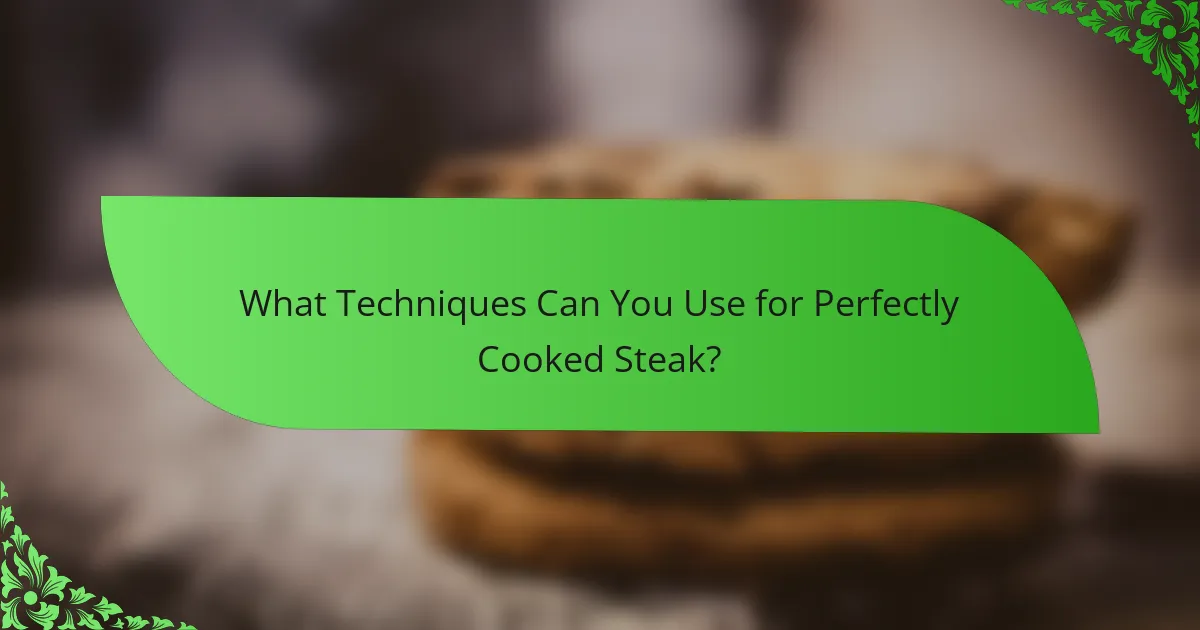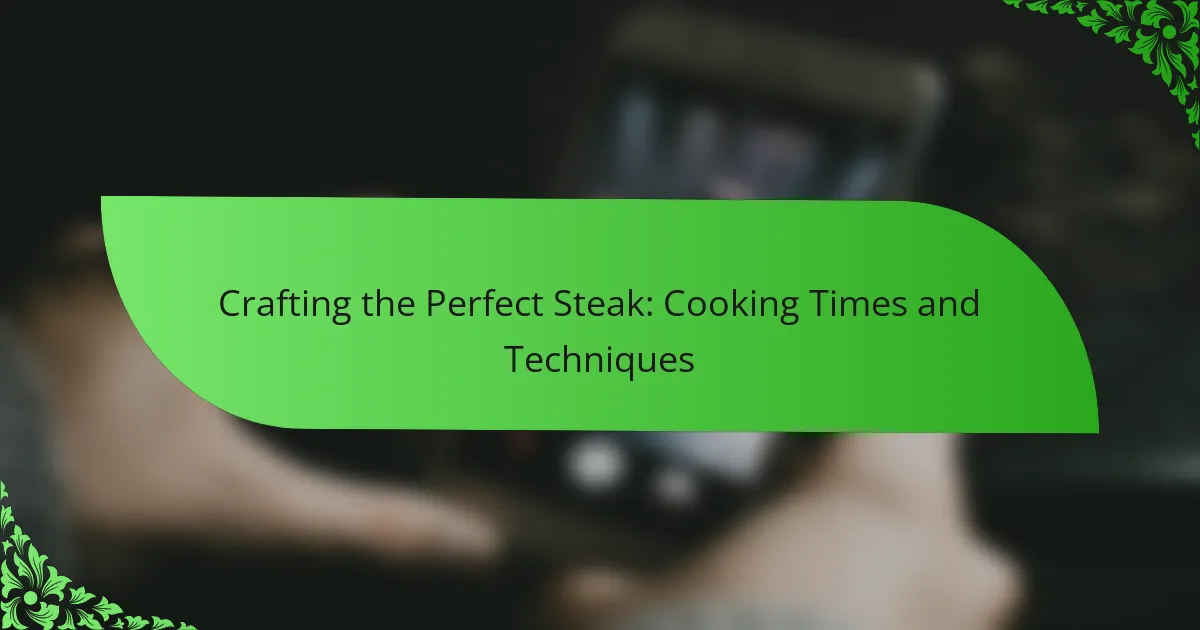The article focuses on crafting the perfect steak, emphasizing key factors such as tenderness, flavor, and cooking techniques. It explains that tenderness is achieved through selecting high-quality cuts, like ribeye or filet mignon, and flavor is enhanced by marbling and proper seasoning with salt and pepper. Various cooking methods, including sous vide, reverse sear, and traditional grilling, are detailed to ensure optimal results, with specific attention to achieving the ideal internal temperature of 130°F to 135°F for medium-rare. The importance of resting the steak post-cooking to allow juices to redistribute is also highlighted, contributing to a moist and flavorful dining experience.

What Makes a Perfect Steak?
A perfect steak is defined by its tenderness, flavor, and proper cooking technique. Tenderness is achieved through the right cut of meat, such as ribeye or filet mignon. Flavor comes from marbling, which provides juiciness and richness. The Maillard reaction, occurring during high-heat cooking, creates a desirable crust. Cooking to the ideal internal temperature enhances both taste and texture. For example, medium-rare is typically around 130-135°F. Resting the steak after cooking allows juices to redistribute, ensuring a moist bite. Proper seasoning with salt and pepper before cooking elevates the overall flavor profile. These factors collectively contribute to the experience of enjoying a perfect steak.
How do different cuts of steak affect the overall quality?
Different cuts of steak significantly affect the overall quality. The tenderness, flavor, and fat content vary among cuts. For example, ribeye is known for its rich marbling and flavor, making it a preferred choice for many. Tenderloin, on the other hand, is prized for its tenderness but has less flavor due to lower fat content. Cuts like flank or skirt steak are leaner and require specific cooking techniques to enhance their texture. The quality also depends on the source of the meat, with grass-fed beef often offering different flavor profiles compared to grain-fed. Overall, the cut determines the cooking method, which in turn influences the final taste and texture of the steak.
What are the most popular cuts of steak and their characteristics?
The most popular cuts of steak include ribeye, sirloin, filet mignon, T-bone, and flank steak. Ribeye is known for its marbling and rich flavor. It is tender and juicy, making it a favorite for grilling. Sirloin is leaner than ribeye but still offers good flavor. It is versatile and can be used in various dishes. Filet mignon is the most tender cut. It has a buttery texture and is often served as a premium option. T-bone combines two cuts: the strip steak and the tenderloin. It provides a balance of flavor and tenderness. Flank steak is lean and flavorful. It is best when marinated and grilled quickly. Each cut has unique characteristics that cater to different cooking methods and preferences.
How does marbling influence flavor and tenderness?
Marbling significantly enhances both flavor and tenderness in meat. Marbling refers to the intramuscular fat found within the muscle tissue. This fat melts during cooking, which adds moisture and richness to the meat. Increased marbling levels correlate with a more flavorful eating experience. Studies show that well-marbled cuts score higher in taste tests. Tenderness is also improved, as the fat helps to break down muscle fibers. The USDA grading system recognizes marbling as a key factor in quality assessment. Higher grades indicate more marbling, leading to better tenderness and flavor.
What role do cooking techniques play in steak preparation?
Cooking techniques are crucial in steak preparation as they directly affect the flavor, texture, and doneness of the meat. Different methods, such as grilling, searing, and sous-vide, impart unique characteristics to the steak. For example, grilling creates a smoky flavor while searing develops a rich crust. The Maillard reaction occurs during high-heat cooking, enhancing taste and aroma. Techniques also influence moisture retention; for instance, sous-vide allows for precise temperature control and even cooking. Proper techniques ensure that steaks reach desired internal temperatures, such as 130°F for medium-rare. Ultimately, the choice of cooking technique can elevate a steak from ordinary to exceptional.
How do dry and wet cooking methods differ?
Dry cooking methods use direct heat to cook food, while wet cooking methods use moisture. Dry methods include grilling, roasting, and baking. These techniques often produce a crispy exterior and concentrated flavors. Wet methods consist of boiling, steaming, and braising. These techniques typically result in tender textures and can enhance moisture retention. The choice of method affects the final taste and texture of the dish. For example, steaks cooked using dry methods often have a charred crust, while those cooked with wet methods may be more succulent.
What are the advantages of grilling vs. pan-searing?
Grilling offers distinct advantages over pan-searing. Grilling imparts a smoky flavor that enhances the taste of the meat. This method allows excess fat to drip away, resulting in a leaner final product. Grilling also creates appealing grill marks and a charred crust, adding texture. In contrast, pan-searing often retains more moisture, which can lead to a different texture. Research indicates that grilling can reduce fat content by up to 30%. This makes it a healthier option for cooking meats. Additionally, grilling can be more efficient for cooking larger cuts or multiple steaks at once. Overall, grilling provides unique flavors and health benefits that pan-searing does not replicate.
Why is understanding cooking times important for steak?
Understanding cooking times is crucial for steak to achieve the desired doneness and flavor. Proper cooking times ensure that the steak is cooked evenly throughout. Different cuts of steak require varying times based on thickness and fat content. For example, a 1-inch thick steak typically needs about 4-5 minutes per side for medium-rare. Cooking steak for too long can lead to dryness and toughness. Conversely, undercooking can result in food safety issues. The USDA recommends a minimum internal temperature of 145°F for beef. Knowing the right cooking times enhances both taste and texture. This knowledge is essential for both home cooks and professional chefs.
How does thickness affect cooking time?
Thickness directly influences cooking time. Thicker cuts of meat require longer cooking to reach the desired internal temperature. For example, a one-inch steak cooks faster than a two-inch steak. The heat penetrates the meat more slowly as thickness increases. Cooking times can vary significantly; a thicker steak may need double the time of a thinner one. This principle is supported by culinary guidelines, which suggest adjusting cooking times based on the thickness of the steak. Therefore, understanding thickness is crucial for achieving optimal doneness.
What are the recommended internal temperatures for different doneness levels?
The recommended internal temperatures for different doneness levels are as follows: Rare is 120-125°F, Medium Rare is 130-135°F, Medium is 140-145°F, Medium Well is 150-155°F, and Well Done is 160°F and above. These temperatures ensure that the steak is cooked to the desired level of doneness. For example, a Medium Rare steak will have a warm red center, while a Well Done steak will be uniformly brown throughout. Cooking to these specific temperatures helps achieve the best flavor and texture.

How Can You Achieve the Best Flavor in Steak?
To achieve the best flavor in steak, select high-quality cuts with good marbling. Marbling refers to the intramuscular fat that enhances flavor and tenderness. Season the steak generously with salt and pepper before cooking. This simple seasoning helps to enhance the natural flavors of the meat.
Cook the steak using high heat methods such as grilling or pan-searing. These methods create a flavorful crust through the Maillard reaction. Aim for an internal temperature of 130°F to 135°F for medium-rare, which is optimal for flavor retention. Let the steak rest for at least five minutes after cooking. Resting allows the juices to redistribute, ensuring a juicy and flavorful bite.
Using these techniques maximizes the flavor profile of the steak, making it a delicious meal.
What seasonings and marinades enhance steak flavor?
Seasonings and marinades that enhance steak flavor include salt, pepper, garlic, rosemary, and soy sauce. Salt amplifies the natural flavors of steak. Black pepper adds a mild heat and complexity. Garlic infuses a rich aroma and taste. Rosemary contributes a fragrant, earthy note. Soy sauce introduces umami and moisture. Marinades often contain acid, like vinegar or citrus, which tenderizes the meat. A study shows that marinating steak can improve tenderness and flavor retention during cooking.
How do different herbs and spices complement various cuts?
Different herbs and spices enhance the flavor profiles of various cuts of meat. For instance, rosemary pairs well with lamb, adding a fragrant note. Thyme complements beef cuts, providing earthy undertones. Garlic enhances the taste of pork, bringing out its natural sweetness. Paprika adds a smoky flavor to chicken, making it more savory. Oregano works well with grilled meats, offering a robust flavor. Each herb or spice interacts uniquely with the meat’s natural juices, enhancing overall taste. The choice of herbs and spices can elevate the dining experience significantly.
What is the impact of marinating time on flavor absorption?
Marinating time significantly affects flavor absorption in meat. Longer marinating times allow flavors to penetrate deeper into the meat fibers. Typically, marinating for at least 30 minutes enhances flavor, while 2 to 24 hours can maximize absorption. However, marinating for too long, especially with acidic ingredients, can lead to textural changes. For example, chicken benefits from a 1 to 2-hour marinade, while tougher cuts like beef may require longer durations. Research shows that proteins in meat can absorb flavors more effectively up to a certain time limit. After that, diminishing returns occur.
How does resting steak after cooking improve taste?
Resting steak after cooking improves taste by allowing the juices to redistribute throughout the meat. When steak cooks, the heat causes the juices to move towards the surface. If cut immediately, these juices escape, leading to dryness. Resting allows the juices to settle back into the fibers of the meat. This process enhances the overall flavor and tenderness. Studies show that resting can retain up to 20% more juices. A typical resting time is about 5 to 10 minutes for optimal results. This simple step significantly elevates the eating experience.
Why is it essential to let steak rest before slicing?
Letting steak rest before slicing is essential to retain its juices. When steak cooks, its muscle fibers contract and push juices toward the center. Resting allows these fibers to relax, redistributing the juices throughout the meat. This process minimizes juice loss when slicing, resulting in a more flavorful and moist steak. Studies show that resting meat for at least five to ten minutes significantly improves juiciness. The USDA recommends this practice for optimal texture and taste.
What is the optimal resting time for different steak cuts?
The optimal resting time for different steak cuts varies. For tender cuts like filet mignon, resting for 5 to 10 minutes is ideal. Ribeye steaks benefit from a resting period of 10 to 15 minutes. For sirloin and flank steaks, a resting time of 5 to 10 minutes is sufficient. Tougher cuts like brisket should rest for 15 to 30 minutes. These resting times allow juices to redistribute, enhancing flavor and tenderness. According to the USDA, resting meat helps retain moisture, leading to a better eating experience.
What are common mistakes to avoid when cooking steak?
Common mistakes to avoid when cooking steak include not letting the steak rest before cooking. Resting allows juices to redistribute, enhancing flavor. Another mistake is cooking steak straight from the refrigerator. This can lead to uneven cooking. Failing to season adequately is also a frequent error. Proper seasoning enhances the steak’s natural flavors. Overcooking is a significant mistake. Using a meat thermometer helps achieve the desired doneness. Not using high enough heat can result in a lack of sear. A good sear locks in moisture and flavor. Lastly, cutting into the steak immediately after cooking allows juices to escape. Allowing the steak to rest after cooking keeps it juicy.
How can overcooking affect flavor and texture?
Overcooking can significantly alter the flavor and texture of steak. When steak is overcooked, it loses moisture, resulting in a dry texture. This dryness can make the meat tough and chewy. Additionally, overcooking can lead to the Maillard reaction being pushed too far, which creates a burnt flavor. The ideal flavor profile is achieved at specific cooking temperatures. For example, medium-rare steak is typically cooked to about 130-135°F, preserving juiciness and tenderness. Cooking beyond this range can negatively impact the overall eating experience. Studies show that overcooked meats can have lower palatability scores due to these changes in flavor and texture.
What are the signs of undercooked steak and how to address them?
Signs of undercooked steak include a cool or rare center, excessive blood or juice when cut, and a soft texture. The internal temperature of undercooked steak is typically below 145°F (63°C). To address undercooked steak, return it to the heat source. Cook it for an additional few minutes on each side. Use a meat thermometer to check for the desired doneness. For medium-rare, aim for 130-135°F (54-57°C). For medium, target 140-145°F (60-63°C). This ensures safe consumption and optimal flavor.

What Techniques Can You Use for Perfectly Cooked Steak?
To achieve perfectly cooked steak, utilize techniques such as sous vide, reverse sear, and traditional grilling. Sous vide involves vacuum-sealing the steak and cooking it in a water bath at a precise temperature for an extended period. This method ensures even cooking throughout the meat, resulting in tenderness. Reverse searing starts with cooking the steak at a low temperature in the oven, followed by a high-heat sear on the grill or skillet. This technique enhances flavor and creates a desirable crust. Traditional grilling requires preheating the grill and cooking the steak over direct heat, flipping once for even cooking. Each method allows for control over temperature and doneness, contributing to optimal results.
How do you properly sear a steak?
To properly sear a steak, start by heating a pan over high heat. Use a heavy skillet or cast iron pan for even heat distribution. Add a high smoke point oil, such as canola or avocado oil. Ensure the oil is shimmering before adding the steak. Place the steak in the pan without overcrowding. Press down lightly for even contact with the surface. Sear for 2-3 minutes without moving it. Flip the steak and sear the other side for another 2-3 minutes. The ideal internal temperature for medium-rare is 130-135°F. Rest the steak for a few minutes before slicing. This technique locks in juices and enhances flavor.
What are the steps to achieve a perfect crust?
To achieve a perfect crust on a steak, start with a dry surface. Pat the steak with paper towels to remove moisture. Season the steak generously with salt and pepper. This enhances flavor and promotes crust formation. Preheat a cast-iron skillet or grill to high heat. A hot surface is essential for searing. Add oil with a high smoke point, such as canola or avocado oil. Place the steak in the skillet without overcrowding. Sear for 2-3 minutes on each side without moving it. This allows for a deep brown crust to form. Use a meat thermometer to check for desired doneness. A crust develops best when the steak is cooked to medium-rare, around 130-135°F. Rest the steak for a few minutes after cooking. This helps retain juices and maintains the crust integrity.
How does the choice of oil affect the searing process?
The choice of oil significantly impacts the searing process. Different oils have varying smoke points, which is the temperature at which they start to smoke and break down. For instance, oils like canola and grapeseed have high smoke points, around 400°F to 450°F. This allows for effective searing without burning the oil.
Conversely, oils with lower smoke points, such as extra virgin olive oil, can start to smoke at around 375°F. This can lead to off-flavors and a less desirable sear. The oil’s flavor profile also influences the final taste of the steak. Neutral oils provide a clean taste, while flavored oils can enhance the overall flavor.
Therefore, selecting an oil with a high smoke point is crucial for achieving a proper sear. This ensures that the steak develops a rich crust while maintaining its juiciness.
What is the best way to use a meat thermometer?
The best way to use a meat thermometer is to insert it into the thickest part of the meat. Ensure that the thermometer does not touch bone or fat. This placement provides the most accurate temperature reading. For steaks, aim for a temperature of 130°F for medium-rare. Allow the meat to rest after cooking for optimal juiciness. The USDA recommends cooking beef to a minimum internal temperature of 145°F for safety. Using a meat thermometer helps prevent overcooking and ensures desired doneness.
How do you accurately check the internal temperature?
To accurately check the internal temperature of a steak, use a meat thermometer. Insert the thermometer into the thickest part of the steak, avoiding bone and fat. Wait for a few seconds until the reading stabilizes. For medium-rare, the temperature should be 130-135°F. For medium, aim for 140-145°F. For well-done, the target is 160°F and above. Using a thermometer ensures precise cooking and food safety. According to the USDA, proper cooking temperatures prevent foodborne illnesses.
What are the differences between instant-read and probe thermometers?
Instant-read thermometers provide quick temperature readings, typically within a few seconds. They are designed for surface readings and do not remain in food while cooking. In contrast, probe thermometers can be left in the food during cooking. They often include a digital display that shows the temperature in real-time. Instant-read thermometers are ideal for checking temperatures at the end of cooking. Probe thermometers allow for continuous monitoring, providing more precise cooking control. The accuracy of both types is essential for food safety and achieving desired doneness.
What tips can help ensure consistent results when cooking steak?
To ensure consistent results when cooking steak, start with high-quality meat. Choose cuts that are well-marbled for better flavor and tenderness. Allow the steak to come to room temperature before cooking. This helps it cook evenly. Preheat your cooking surface, whether it’s a grill or skillet, to a high temperature. A hot surface sears the steak, locking in juices. Use a meat thermometer to check doneness accurately. For example, 130°F is medium-rare. Let the steak rest after cooking for at least five minutes. Resting allows juices to redistribute, enhancing flavor. Finally, slice against the grain for better texture and tenderness.
How can you practice precision in cooking times?
To practice precision in cooking times, use a reliable timer for each cooking phase. Set timers based on specific recipes to avoid overcooking. Utilize a meat thermometer to check internal temperatures accurately. For steak, the USDA recommends 145°F for medium rare. Adjust cooking times based on steak thickness; thinner cuts cook faster. Preheat your cooking surface to ensure consistent heat. Familiarize yourself with cooking techniques like searing and resting for optimal results. Following these steps can enhance your cooking accuracy significantly.
What techniques can help you troubleshoot common cooking issues?
To troubleshoot common cooking issues, several techniques can be employed. First, check the cooking temperature. An incorrect temperature can lead to undercooked or overcooked food. Use a meat thermometer to ensure proper doneness. For steak, the USDA recommends an internal temperature of 145°F for medium rare.
Next, assess cooking times. Overcooking can dry out the steak, while undercooking can pose health risks. Follow established cooking times based on the thickness of the steak and desired doneness. For example, a 1-inch steak typically requires about 4-5 minutes per side on high heat for medium rare.
If a steak is tough, consider the cut and how it was prepared. Tough cuts benefit from marinating or slow cooking to break down fibers. If the steak is dry, it may have been cooked too long or at too high a temperature.
Lastly, allow the steak to rest after cooking. Resting helps redistribute juices, resulting in a more flavorful and tender steak. Aim for a resting period of 5-10 minutes before slicing. These techniques can effectively address and resolve common cooking issues.
The main entity of this article is the perfect steak, defined by its tenderness, flavor, and cooking techniques. Key topics include the impact of different cuts on quality, the significance of marbling, and the importance of cooking methods like grilling and pan-searing. The article also covers optimal internal temperatures for various doneness levels, the role of resting in flavor enhancement, and common mistakes to avoid when cooking steak. Techniques for achieving a perfect crust and tips for ensuring consistent cooking results are also discussed, providing a comprehensive guide to crafting the ideal steak.
